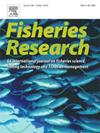Tracking the marine migrations of coho salmon through otolith microchemistry
IF 2.2
2区 农林科学
Q2 FISHERIES
引用次数: 0
Abstract
Coho salmon (Oncorhynchus kisutch) are an important species to Southern British Columbia both culturally, ecologically, and economically; unfortunately, since the 1990’s significant declines in abundance and survival have occurred in this region for several populations. While marine survival rates have been declining, where these fish migrate to in the ocean within these populations has also been changing. These shifts can vary considerable from year to year, depending on the population. While tracking marine migrations with traditional tagging approach is no longer feasible given the few returns, otolith microchemistry provides an alternative approach, by comparing otoliths of adult coho that returned to the freshwater to spawn to coho caught in different marine regions: in freshwater, adults (n = 147) were collected from various hatcheries in the fall of 2017 and 2018, and in marine waters, individuals (n = 202) were collected from the Strait of Georgia (SoG) and the West Coast of Vancouver Island (WCVI) in May through July of 2017 and 2018. Otolith samples were analyzed for both trace/minor elements and stable isotopes (δ13C, δ18O). Hatchery samples were classified as either SoG residents, WCVI migrants, or unknowns using random forest classification models. Otolith chemistry of ocean caught samples from the SoG and WCVI differed from one another (F=4.754, df= 1, p < 0.001), with 138Ba and δ18O being the main drivers of these differences. Random forest models were accurate (∼95 %) with low out-of-bag error rates (<10 %) across both 2017 and 2018. Freshwater caught adults were consistently assigned (≥80 % of the random forest models across set seeds) to the SoG or WCVI 83.7 % of the time. 70.6 % of 2017 samples and 38.9 % of 2018 samples were predicted to be SoG residents. Using random forest classification models, and 41.2 % of 2017 samples and 42.5 % of 2018 samples were predicted to be Strait of Georgia residents. This study is the first to demonstrate the utility of both otolith trace/minor elements and stable isotopes to track the marine migrations of Pacific salmon. The use of the otolith as an intrinsic tag provides fisheries managers with an alternative, non-fisheries dependent approach to assess the marine distributions of these fish.
利用耳石微化学追踪银鲑的海洋迁徙
银鲑(Oncorhynchus kisutch)是不列颠哥伦比亚省南部重要的文化、生态和经济物种。不幸的是,自20世纪90年代以来,该地区几个种群的数量和存活率都出现了显著下降。虽然海洋存活率一直在下降,但这些鱼类在海洋中的迁徙地点也在发生变化。这些变化每年都有相当大的变化,这取决于人口。由于回报少,用传统的标记方法跟踪海洋迁徙已不再可行,耳石微化学提供了一种替代方法,通过将返回淡水产卵的成年银银鱼的耳石与在不同海洋地区捕获的银银鱼的耳石进行比较:在淡水中,于2017年和2018年秋季从各个孵化场收集成虫(n = 147),在海水中,于2017年5月至2018年7月从乔治亚海峡(SoG)和温哥华岛西海岸(WCVI)收集个体(n = 202)。分析了耳石样品的微量元素和稳定同位素(δ13C, δ18O)。使用随机森林分类模型将孵化场样本分为SoG居民、WCVI候鸟或未知物种。SoG和WCVI海洋捕获样品的耳石化学性质存在差异(F=4.754, df= 1, p <; 0.001),其中138Ba和δ18O是造成这些差异的主要原因。随机森林模型在2017年和2018年都是准确的(~ 95 %),袋外错误率很低(<10 %)。淡水捕获的成虫被一致地分配到SoG或WCVI(83.7 %的时间)(≥80 %的随机森林模型跨种子)。2017年和2018年分别有70.6 %和38.9 %的样本预测为SoG居民。使用随机森林分类模型,预测2017年样本的41.2 %和2018年样本的42.5 %是乔治亚海峡居民。这项研究首次展示了耳石痕量/微量元素和稳定同位素在追踪太平洋鲑鱼海洋迁徙中的作用。耳石作为内在标签的使用为渔业管理人员提供了一种非渔业依赖的替代方法来评估这些鱼类的海洋分布。
本文章由计算机程序翻译,如有差异,请以英文原文为准。
求助全文
约1分钟内获得全文
求助全文
来源期刊

Fisheries Research
农林科学-渔业
CiteScore
4.50
自引率
16.70%
发文量
294
审稿时长
15 weeks
期刊介绍:
This journal provides an international forum for the publication of papers in the areas of fisheries science, fishing technology, fisheries management and relevant socio-economics. The scope covers fisheries in salt, brackish and freshwater systems, and all aspects of associated ecology, environmental aspects of fisheries, and economics. Both theoretical and practical papers are acceptable, including laboratory and field experimental studies relevant to fisheries. Papers on the conservation of exploitable living resources are welcome. Review and Viewpoint articles are also published. As the specified areas inevitably impinge on and interrelate with each other, the approach of the journal is multidisciplinary, and authors are encouraged to emphasise the relevance of their own work to that of other disciplines. The journal is intended for fisheries scientists, biological oceanographers, gear technologists, economists, managers, administrators, policy makers and legislators.
 求助内容:
求助内容: 应助结果提醒方式:
应助结果提醒方式:


